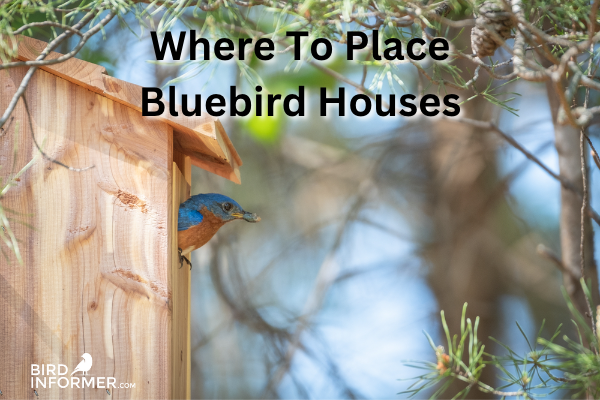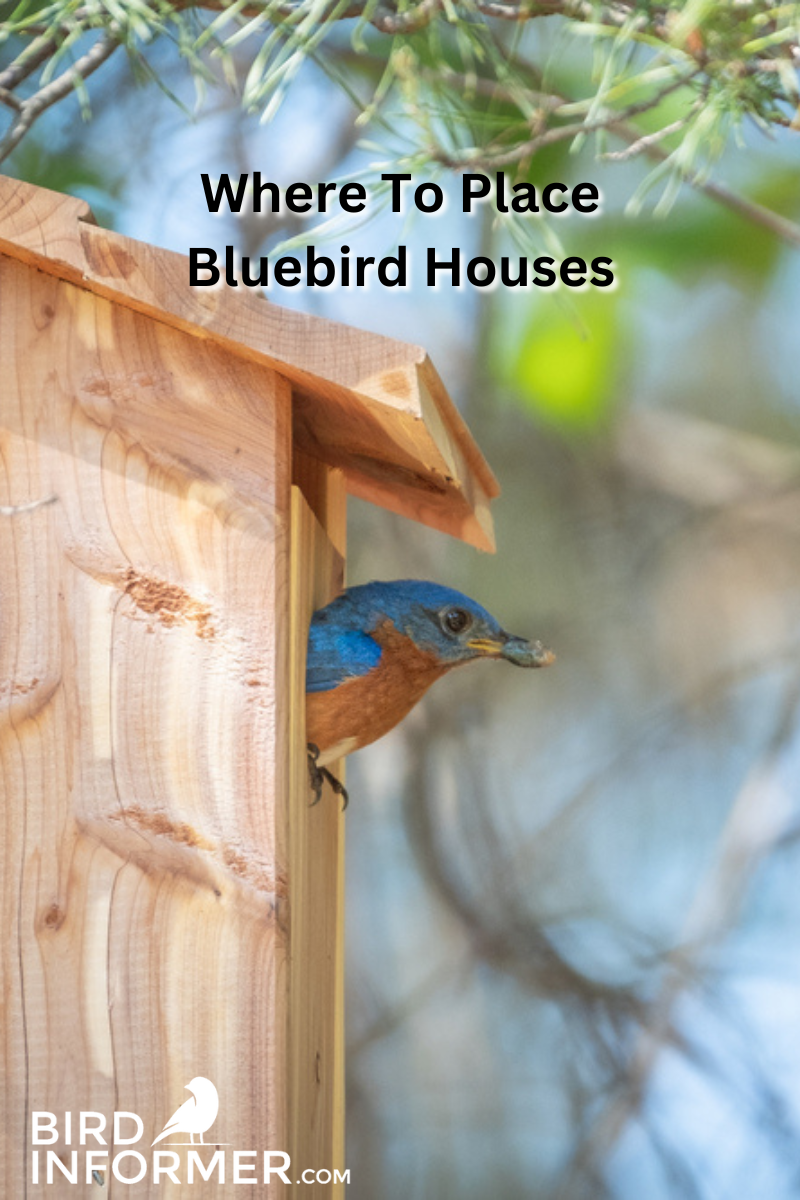Contents
- Provide Plenty Of Space: Put Your Bluebird House In An Open Area
- Perch Perfect: Provide Bluebirds A Place To Perch To Attract Them To Your Backyard
- Where To Place Bluebird Houses: Stability Is Key
- The Height Of Perfection: Practice The 5 Foot Bluebird Nest Boxes Rule
- Unwelcome Guests Begone: Prevent House Sparrows From Outcompeting The Bluebirds For Space
- FAQs About Placing Bluebird Houses
- Conclusion
Are you ready to install a new bluebird house at home? Do you know the perfect location to choose? Keep reading to discover the ideal spot to place your bluebird house this spring.
The ideal place for an Eastern bluebird house is in a wide-open, sunny backyard. Keep it out of the shade or away from the house. Give bluebirds a flying path facing a field if possible. Keep the birdhouse 100ft from the feeder. Install it 5-10ft off the ground and keep it anchored firmly to prevent swaying.
As you can see, there are a number of things to consider when determining where to place bluebird houses. Creating the ideal environment or finding the perfect location is the difference between attracting bluebirds and failing to do so.
To learn more about picking the most attractive location for bluebird houses and other significant information, please keep reading below.
Related article: What is the difference between a bluebird and a blue jay?
Provide Plenty Of Space: Put Your Bluebird House In An Open Area
First things first…
Bluebirds love to devour insects during the summertime and consider it their main source of food. With this in mind, they need to live in a location with wide-open spaces and plenty of sunlight while nesting or roosting. This area should be filled with a plethora of short grass and an ample supply of all kinds of insects.
In fact, bluebirds love to munch on the following insects, which make up the majority of their diet. They include:
- caterpillars
- spiders
- grasshoppers
- beetles
- crickets
- mealworms
- grubs
- termites
- snails
- and other insects
According to onthefeeder.com, “In the wild, bluebirds love to snack on snails, slugs, earthworms, and grubs. They are drawn to insect larvae and enjoy crickets, beetles, grasshoppers, termites, and ants. Bluebirds also eat spiders and the previously mentioned mosquito.”
Clearly, it’s best to keep your nest box in a wide-open environment with lots of grass and fields so plenty of these tasty insects are available for your favorite bluebirds and other songbirds to eat so they can maintain a healthy diet.
Also, while choosing the perfect location in your backyard, consider facing the bluebird birdhouse toward an open expanse of grass. If possible, put it on the edge of your property so the birdhouse overlooks the rest of your large and wide-open backyard.
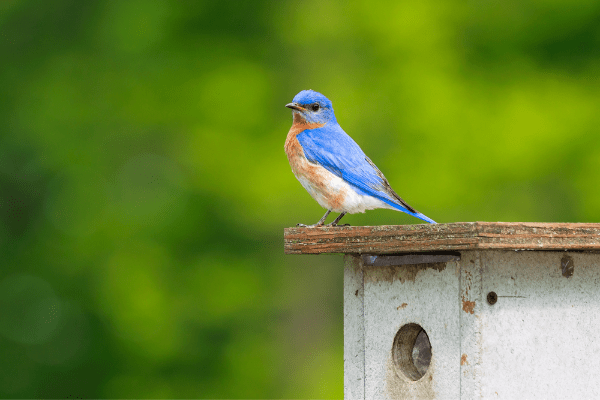
Related article: What Does It Mean Spiritually When You See A Bluebird?
Perch Perfect: Provide Bluebirds A Place To Perch To Attract Them To Your Backyard
This bonus tip is designed to make your backyard more attractive to bluebirds. If you offer the things that they like, they’ll have no problem moving into your bluebird house because all of their favorite amenities like open spaces, plenty of insects, and hunting perches are made available to them.
In this particular case, it’s best to design your backyard in a way that provides low perches for bluebirds because they love to use that while hunting. Consider adding shrubs, small trees, or low fence posts to your backyard. Keep them low enough to the ground so that the bluebirds will be able to easily discover insects from their perch.
Really take this into consideration. If you want bluebirds to be attracted to your backyard, then having one or more low perches is definitely a great idea.
Where To Place Bluebird Houses: Stability Is Key
According to PennState Extension, “Mounting nest boxes on poles instead of trees enables you to place them in locations that will decrease the chance that they will be used by birds other than bluebirds. To reduce competition from house wrens, which prefer to nest near brushy cover, locate boxes at least 100 feet from tree lines and shrubs.”
That makes sense, right?
As a bluebird lover looking to attract them to your backyard, the last thing you’d want to do is attract house wrens and other birds to their nest box. This would ultimately defeat the purpose of creating the perfect bluebird habitat to attract these beautiful creatures to your home.
Keeping house wrens and other birds like starlings or House sparrows away is only one reason to mount a bluebird box on top of a pole.
Here’s another reason:
When mounting a nest box in a tree, for example, it will often sway in the breeze and remain unstable. Bluebirds will not tolerate the instability. As soon as they realize that the nest boxes aren’t stable, they will abandon them altogether and never go back.
Mounting the box on a pole will provide tremendous stability even if it’s windy, rainy, or potentially disturbed during inclement weather. The pole must be in the ground and remain sturdy and strong in order to prevent instability whenever a strong gust of wind blows through your backyard.
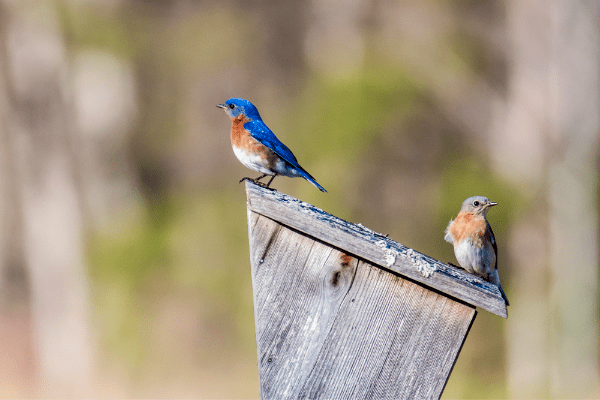
The Height Of Perfection: Practice The 5 Foot Bluebird Nest Boxes Rule
Generally speaking, experts recommend placing your new bluebird box anywhere from 5-10 feet off the ground. Ideally, I would take it a step further and recommend keeping it 5 feet off the ground and no higher.
Why?
Simply put, by keeping it 5 feet off the ground, you are keeping it low enough so bluebirds can perch on top of their nest boxes and spot insects and other prey directly from their home-based perch.
According to bluebirdlandlord.com, “Mount the nest box at least 5 feet off the ground, not too close to buildings, and at least 50 feet away from brushy or wooded areas.”
I’ll go into further detail about the reasons why it should be at least 50-100 feet away from the brushy or wooded area below. But know that keeping the nest boxes as close to the ground as possible makes it easier than ever for bluebirds to discover insects and other prey that they can use to feed themselves and their hatchlings.
Finally, I’d like to mention that house sparrows will likely avoid nest boxes that are 5 feet in height or lower, which is also another great benefit to keeping it relatively low to the ground.
Related article: Best Bluebird Feeders
Other Guidelines To Consider
Besides placing the nest box 5 feet off the ground, you should consider the following guidelines when choosing the best location. They include:
- Keep your nest box facing a wide-open space (preferably your backyard.) If you have to place the nest box on the edge of your property and face it toward your yard, please do so.
- How far apart should remain between bluebird houses? The Ohio Bluebird Society teaches us that it’s best to keep 18-20 feet apart between bluebird boxes if you’re installing them together as a pair. If you’re installing multiple pairs, keep 100 feet of space between each set of bluebird house pairs.
- If you can ensure stability, then it’s certainly acceptable to hang your bluebird house from a tree. Make sure it’s secured flat against the tree. If the bluebird houses swaying for any reason at all, bluebirds will not use it because they do not like the swaying or rocking motion.
Unwelcome Guests Begone: Prevent House Sparrows From Outcompeting The Bluebirds For Space
As a bluebird aficionado, it’s important to know that house sparrows and other birds tend to compete for space with bluebirds. If you place your nest boxes incorrectly, you might end up building a home for local house sparrows instead of your favorite bluebirds.
How can you prevent this?
As a bird landlord, you’ll have to take the necessary steps to discourage house sparrows from moving into your nest boxes set aside for bluebirds.
Some tips to help you accomplish this task include:
- Monitor your nest boxes daily. If it looks like house sparrows might be invading your nest boxes, it’s best to remove the evidence of their existence from the nest box. As an example, the house sparrows might begin building a nest inside of the box. Since this bird is not protected by law, you can remove the messy scraps of debris from the nest box and clean it out in an effort to protect bluebirds and other native birds.
- Plug the entrance hole temporarily. If the house sparrows are consumed with your bluebird box, you may have to temporarily clean it out and plug the hole for the time being. The house sparrows will eventually lose interest in the nest box, so plugging the hole to help them forget about it is one of the best ways to get them to lose interest. You’ll have to monitor this situation as well to find out when the sparrows are no longer interested in the bluebird house.
- Install a bluebird-safe bird box. They sell sparrow-resistant birdhouses that are designed based on research and bluebird nesting behaviors. Considering another option, they sell bluebird boxes with a Noel Guard on the front. This might not necessarily restrict sparrows from getting in the bird box, but it will keep other critters including squirrels, raccoons, and cats away.
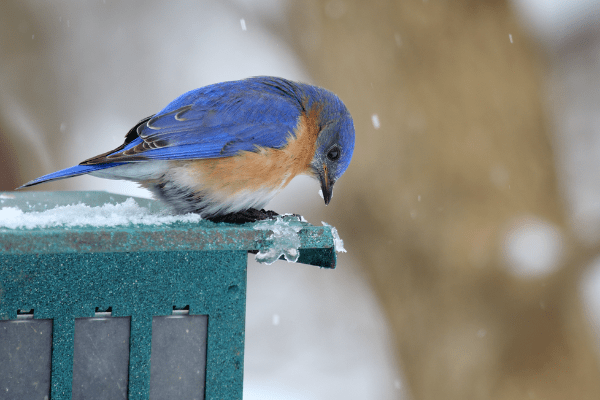
What Other Predators Could Damage Bluebird Nest Boxes?
As you can imagine, there are other native competitors that would love to have access to bluebird nesting boxes. A list of the more common birds that will compete with bluebirds for access to nest boxes includes the following:
- Titmice
- House sparrows
- Nuthatches
- Starlings
- Chickadees
- House wrens
- Tree swallows
None of these birds will necessarily damage the bluebird box, but they will try to take over and make it their home. Make sure the bluebird house has the ideal sized opening to keep larger birds out while allowing bluebirds in without any difficulty.
House swallows and European starlings are major threats to bluebird nesting. These birds will attack the nests, destroy or steal their eggs, and ultimately ruin the beautiful place to live that you created for these gorgeous birds.
For friendly native birds like the list mentioned above, you could always install an additional birdhouse or nest box roughly 10 feet higher and near a wooded area and away from the bluebird box.
FAQs About Placing Bluebird Houses
Many homeowners have important questions that need answering about installing bluebird houses. Some frequently asked questions include:
How Much Space Should I Put Between My Bluebird Houses?
The North American Bluebird Society tells us that it’s possible to attract multiple pairs of bluebirds to your property as long as you have more than one nesting space. When placing your bluebird nest boxes throughout your property, you should keep the following distances in mind for each of these species:
| Species of Bluebird | Space Between Nest Boxes |
| Eastern Bluebirds | 100-150 yards (the further the better) |
| Mountain Bluebirds | 200-300 yards |
| Western Bluebirds | 100-300 yards (the further the better) |
Which Direction Should I Face My Bluebird House?
Bluebirds have a specific directional preference for their nesting boxes to face. The following list is an order of bluebird preferences.
- East
- North
- South
- West
This information was first discovered by Doreen Scriven, the author of Bluebird Trails: A Guide to Success.
Can I Place My Bluebird Nest Box Close To My House?
In all honesty, this really depends on the size and shape of your backyard. If your yard is relatively small, you may need to mount it relatively close to the house. You shouldn’t feel like you’re doing anything wrong. Go ahead and install the bluebird house.
Guess what? This likely will not be a problem as long as there’s lots of open space available in the area. Make sure the area is filled with plenty of natural light as well because it will make it very easy for bluebirds to find the nest box.
I recently read a story about a bluebird lover who had to mount their nest box 30 feet from their house. They thought the bluebirds would avoid it, but nothing was further from the truth. They ended up liking the birdhouse and the location and it was never a problem. Even better, house sparrows avoided the nest box in this location as well, which was definitely a nice added bonus.
Conclusion
To close things out and properly summarize my findings, please remember the following:
When considering where to Place bluebird houses, the ideal location to mount them is in an open and sunny area. Make sure bluebirds have plenty of short grass so that they can find insects hiding within.
Otherwise, pay close attention to the tips and suggestions shared above. This information will make it easier than ever for you to choose the perfect bluebird house location.

